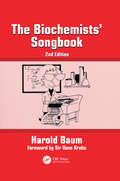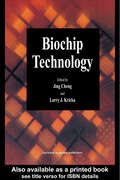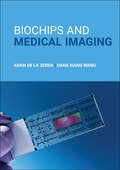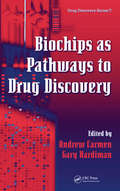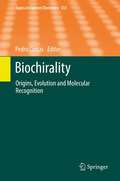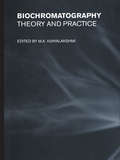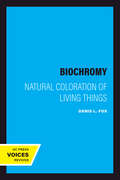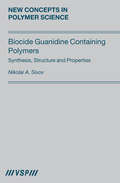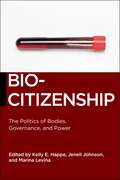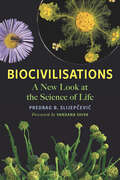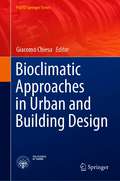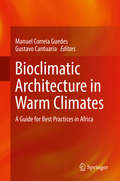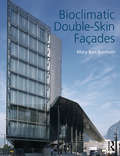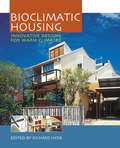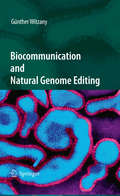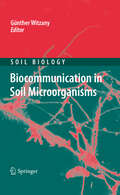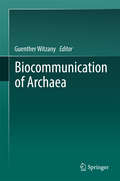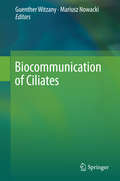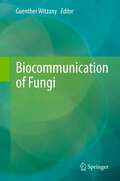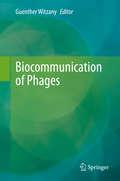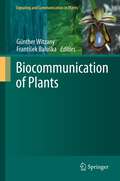- Table View
- List View
Biochemists' Song Book
by Harold BaumThis songbook presents information on biochemical pathways set to well-known songs, providing students with an easy way to remember often complicated information. The songs should also serve as end-of-term review material.
Biochip Technology
by Jing Cheng Larry J. KrickaBiochip technology has experienced explosive growth in recent years and Biochip technology describes the basic manufacturing and fabrication processes and the current range of applications of these chips. Top scientists from the biochip industry and related areas explain the diverse applications of biochips in gene sequencing, expression monitoring
Biochips and Medical Imaging
by Shan Xiang Wang Adam de la ZerdaAdvanced, recent developments in biochips and medical imaging Biochips and Medical Imaging is designed as a professional resource, covering recent biochip and medical imaging developments. Within the text, the authors encourage uniting aspects of engineering, biology, and medicine to facilitate advancements in the field of molecular diagnostics and imaging. Biochips are microchips for efficiently screening biological analytes. This book aims at presenting information on the state-of-the-art and emerging biosensors, biochips, and imaging devices of the body&’s systems, including the endocrine, circulatory, and immune systems. Medical diagnostics includes biochips (in-vitro diagnostics) and medical and molecular imaging (in-vivo imaging). Biochips and Medical Imaging explores the role of in-vitro and in-vivo diagnostics. It enables an instructor to share in-depth examples of the use of biochips in diagnosing cancer and cardiovascular diseases. Provides real-life knowledge on biochips and medical imaging, written by leading researchers Serves as a resource for professionals working in the biochip or imaging fields Features an accessible approach for anyone interested in biochips and their applications Readers of Biochips and Medical Imaging can expand their knowledge of medical technology, even if they have no biological knowledge and a limited math background. With its focus on important developments, this book is sure to also capture the interest of bioengineering and biomaterials scientists, structural biologists, electrical engineers, and nanotechnologists.
Biochips as Pathways to Drug Discovery (Drug Discovery Series)
by Gary Hardiman Andrew CarmenIn the fiercely competitive pharmaceutical marketplace, your organization cannot afford to spend excess dollars developing drugs that will fail to get FDA approval or have profoundly poor characteristics. Biochips as Pathways to Drug Discovery takes a comprehensive look at how the industry faces these challenges, using new technologies such as bioc
Biochirality: Origins, Evolution and Molecular Recognition (Topics in Current Chemistry #333)
by Pedro CintasEarly History of the Recognition of Molecular Biochirality, by Joseph Gal, Pedro Cintas Synthesis and Chirality of Amino Acids Under Interstellar Conditions, by Chaitanya Giri, Fred Goesmann, Cornelia Meinert, Amanda C. Evans, Uwe J. Meierhenrich Chemical and Physical Models for the Emergence of Biological Homochirality, by son E. Hein, Dragos Gherase, Donna G. Blackmond Biomolecules at Interfaces: Chiral, Naturally, by Arántzazu González-Campo and David B. Amabilino Stochastic Mirror Symmetry Breaking: Theoretical Models and Simulation of Experiments, by Celia Blanco, David Hochberg Self-Assembly of Dendritic Dipeptides as a Model of Chiral Selection in Primitive Biological Systems, by Brad M. Rosen, Cécile Roche, Virgil Percec Chirality and Protein Biosynthesis, by Sindrila Dutta Banik, Nilashis Nandi
Biochromatography: Theory and Practice
by M. A. VijayalakshmiThe field of bioseparation, and biochromatography in particular, is advancing very rapidly as our knowledge of the properties of molecules and atomic forces increases. This volume covers the basic principles of biochromatography in detail. It assesses different techniques and includes a large number of applications, providing the reader with a mult
Biochromy: Natural Coloration of Living Things
by Denis L. FoxThis title is part of UC Press's Voices Revived program, which commemorates University of California Press’s mission to seek out and cultivate the brightest minds and give them voice, reach, and impact. Drawing on a backlist dating to 1893, Voices Revived makes high-quality, peer-reviewed scholarship accessible once again using print-on-demand technology. This title was originally published in 1979.
Biocidal
by Ted DracosIn 1962, Rachel Carson stunned the world with the publication of Silent Spring, exposing the lethal character of the pesticide DDT. Her work launched a global campaign against synthetic chemical toxins and veritably created a world environmental movement. But unbeknownst to Carson, an even more insidious chemical cousin to DDT had been silently poisoning the biosphere. Polychlorinated biphenyls (PCBs) were first manufactured in 1920. Seen as a “magic fluid,” they were a cheap and stable heat-transfer material used as a critical coolant in big power grids. The chemical industry soon went on to develop hundreds of other uses for this highly toxic group of substances—everything from copy paper and paint to hydraulic fluids. Despite being outlawed in the U.S. since 1976, PCBs are currently found in the remotest corners of Earth and remain the most prevalent group of industrial chemical contaminants in much of the world. Every human being, from the womb to the grave, bears a body burden of these poisonous molecules forever locked in their blood and tissues. In Biocidal, investigative journalist Ted Dracos tells the full story of PCBs for the first time, starting with the chilling chronicle of how the chemical industry manipulated regulatory agencies and scientific findings for decades to continue to reap huge profits, despite their knowledge of the threats posed by their “magic fluid.” Dracos draws on extensive research to document the connection between PCBs and catastrophic human illness, presenting the latest science as studies draw ever more disturbing links between PCBs and continued health impacts ranging from cancer and autism to immunosuppression and reproductive abnormalities. Biocidal also explores the science behind the threat PCBs pose to Earth’s biodiversity: today, killer whales in the Puget Sound are dying, the eggs of Ontario Lake trout are doomed before they can hatch, 99 percent of the freshwater eels of Europe have disappeared, and frogs around the world are going extinct. While these disasters have many possible causes, evidence pointing to PCBs keeps accumulating, much like the toxins in these animals’ systems. Nonetheless, Dracos leaves readers with a profound message of hope: the damage is not irreversible. In fact, cleanup efforts that involve the removal of the source of PCBs can really work, and quickly. Offering a simple blueprint for steps that can be taken to reduce the impacts of all industrial chemicals, Biocidal ultimately points the way toward a detoxified world.
Biocide Guanidine Containing Polymers: Synthesis, Structure and Properties
by SivovThis volume deals with chemistry of polyelectrolytes, namely biocide guanidine containing polymers, discussing both synthesis of new guanidine containing monomers of diallyl and acrylic nature and their structure and investigation of their radical (co)polymerization and properties of new (co)polymers.The first parts of the book describe radical pol
Biocitizenship: The Politics of Bodies, Governance, and Power (Biopolitics #19)
by Kelly E. Happe Jenell Johnson Marina LevinaA groundbreaking exploration of biocitizenshipCitizenship has a long, complex relationship with the body. In recent years, developments in biomedicine and biotechnology, as well as a number of political initiatives, grassroots efforts, and public policies have given rise to new ways in which bodies shape the idea and practices of citizenship, or what has been called “biocitizenship.” This book, the first collection of essays on the topic of biocitizenship, aims to examine biocitizenship as a mode of political action and expand readers’ understanding of biopolitics. Organized into four distinct sections covering topics including AIDS, drug testing on the mentally ill, and force-feeding prisoners, Biocitizenship delves deep into the relationship between private and public identity, politics, and power. Composed of pieces by leading scholars from a wide variety of disciplines, Biocitizenship offers a clear and comprehensive discussion on biocitizenship, biopolitics, and groups that may be affected by this ever-growing dialogue. Authors address issues familiar to biopolitics scholarship such as gender, sexuality, class, race, and immigration, but also consider unique objects of study, such as incubators, dead bodies, and corporations. Biocitizenship seeks to question who may count as a biological citizen and for what reasons, an essential topic in an age in which the body and its health provide the conditions necessary for political recognition and agency.
Biocivilisations: A New Look at the Science of Life
by Predrag B. Slijepcevic2024 Nautilus Book Award Gold Medal Winner: Restorative Earth Practices"A brilliant book [that] shows a way out of the destructive trap of Anthropocentric arrogance."—Vandana Shiva, author of Terra Viva"An unusually thought-provoking and ambitious book."—Dr. James A. Shapiro, author of Evolution: A View from the 21st CenturyBiocivilisations is an important, original rethinking of the mystery of life and its deep uncertainty, exploring the complex civilisations that existed on Earth long before humans.What is life? Many scientists believe life can be reduced to &‘mechanistic&’ factors, such as genes and information codes. Yet there is a growing army of scientists, philosophers and artists who reject this view. The gene metaphor is not only too simplistic but deeply misleading. If there is a way to reduce life to a single principle, that principle must acknowledge the creativity of life, turning genetic determinism on its head.The term biocivilisations is the acknowledgement of this uncertainty of life, as opposed to a quasi-certainty of the human position governed by a narrow time window of the scientific revolution. Life existed without humans for more than 99.99 percent of the Earth&’s existence. Life will also continue without humans long after our inevitable extinction.In Biocivilisations, Dr Predrag Slijepčević shows how bacteria, amoebas, plants, insects, birds, whales, elephants and countless other species not only preceded human beings but demonstrate elements of how we celebrate human civilisation – complex communication, agriculture, science, art, medicine and more.Humans must try to adopt this wisdom from other biocivilisations that have long preceded our own. By rethinking the current scientific paradigm, Dr Slijepčević makes clear that a transformation – from a naïve young species into a more mature species in tune with its surroundings – will save us from our own violence and the violence we inflict on the rest of our living planet."Read this book if you would like to understand the intelligence of living systems."—Dr Denis Noble, University of Oxford
Biocivilisations: A New Look at the Science of Life
by Predrag B. Slijepčević*2024 Nautilus Book Award Gold Medal Winner: Restorative Earth Practices "A brilliant book [that] shows a way out of the destructive trap of Anthropocentric arrogance."—Vandana Shiva, author of Terra Viva "An unusually thought-provoking and ambitious book."—Dr. James A. Shapiro, author of Evolution: A View from the 21st Century Biocivilisations is an important, original rethinking of the mystery of life and its deep uncertainty, exploring the complex civilisations that existed on Earth long before humans. What is life? Many scientists believe life can be reduced to ‘mechanistic’ factors, such as genes and information codes. Yet there is a growing army of scientists, philosophers and artists who reject this view. The gene metaphor is not only too simplistic but deeply misleading. If there is a way to reduce life to a single principle, that principle must acknowledge the creativity of life, turning genetic determinism on its head. The term biocivilisations is the acknowledgement of this uncertainty of life, as opposed to a quasi-certainty of the human position governed by a narrow time window of the scientific revolution. Life existed without humans for more than 99.99 percent of the Earth’s existence. Life will also continue without humans long after our inevitable extinction. In Biocivilisations, Dr Predrag Slijepčević shows how bacteria, amoebas, plants, insects, birds, whales, elephants and countless other species not only preceded human beings but demonstrate elements of how we celebrate human civilisation – complex communication, agriculture, science, art, medicine and more. Humans must try to adopt this wisdom from other biocivilisations that have long preceded our own. By rethinking the current scientific paradigm, Dr Slijepčević makes clear that a transformation – from a naïve young species into a more mature species in tune with its surroundings – will save us from our own violence and the violence we inflict on the rest of our living planet. "Read this book if you would like to understand the intelligence of living systems."—Dr Denis Noble, University of Oxford
Bioclimatic Approaches in Urban and Building Design (PoliTO Springer Series)
by Giacomo ChiesaThis book explores the bioclimatic approach to building design. Constant innovations in the field are evident, including the need to face climate changes and increase the local resilience at different scales (regional, urban, architectural). Differently from other contributions, this book provides a definition of the bioclimatic design approach following a technological and performance-driven vision. It includes one of the largest collection of research voices on the topic, becoming also a critical reference work for bioclimatic theory. It is intended for architects, engineers, researchers, and technicians who have professional and research interests in bioclimatic and in sustainable and technological design issues.
Bioclimatic Architecture in Warm Climates: A Guide for Best Practices in Africa
by Manuel Correia Guedes Gustavo CantuariaThis book provides a comprehensive, hands-on approach to bioclimatic building design in Africa. Bioclimatic design is at the core of urban sustainability, and is a critical issue in Africa, where “imported” building typologies are being used at an increasing pace, disregarding the local context and consequently causing damage to the environment, to the economy, and to the culture itself. This book provides a concise set of sustainable design guidelines to be applied in both new buildings and the refurbishment of old buildings, and integrates bioclimatic design strategies with other sustainability issues such as: cultural aspects, affordability, and urban planning. Chapters are fully illustrated with photographs and drawings and include best-practice examples and strategies making it accessible to engineers, architects, students and a broad range of professionals in the building industry. Encompasses all climatic regions in Africa;Integrates bioclimatic design strategies with other sustainability issues;Discusses new design to refurbishment, from urban to rural, including office buildings, residential, tourism, social housing and self building.
Bioclimatic Double-Skin Façades
by Mary Ben BonhamVisually enriched with over 250 photographs and drawings, Bioclimatic Double-Skin Façades is an essential reference guide for understanding the types and functions of double-skin façades. Author Mary Ben Bonham examines the history and continuing potential of double-skin architecture, informing on the variety of approaches possible and advising a rigorous integrated design process leading to application. Featuring a wide selection of architectural examples, the book will be of interest to professionals and students within the fields of architecture, engineering, and construction. Characterized by a buffer-like air space between two glazed building skins, double-skin windows and façades aim to improve building comfort and energy performance. Double skins introduce complexity and initial costs, yet significant buildings in locations around the globe continue to select this approach. In addition to exploring motivations, benefits, and cautions for designing with double skins, the book provides a primer on fundamental façade design concepts and strategies for control of thermal, luminous, and acoustic environments. Chapters also address alternative types of high-performance façades and implications for each phase of façade design and construction. Bioclimatic Double-Skin Façades promotes bioclimatic design that is inspired by nature, measured in performance, and uniquely adapted to climate and place. In-depth case studies illustrate how double-skin façades have been adapted to a range of climates and cultural settings: Marseille Library and Grenoble Courthouse in France, Cambridge Public Library in Massachusetts, Manitoba Hydro Place in Canada, and the Pearl River Tower in China.
Bioclimatic Housing: Innovative Designs for Warm Climates
by Richard HydeIn the search for sustainable architecture, there is growing interest in the relationship between nature and design. In this vital new book, the termbioclimatic relating to the dynamic between climate and living organisms, is applied by the authors in focusing on countries where housing requires cooling for a significant part of the year. In this context, Bioclimatic Housing covers creative, vernacular architecture to present both the theory and practice of innovative, low-energy architecture. The book interweaves the themes of social progress, technological fixes and industry transformation within a discussion of global and country trends, climate types, solutions and technologies. Prepared under the auspices of a 5-year International Energy Agency (IEA) project, and with case studies from Iran, Malaysia, Australia, Japan, Sri Lanka and Italy, this is a truly international and authoritative work, providing an essential primer for building designers, builders, developers and advanced students in architecture and engineering.
Biocoating for Fertilizer Industry (SpringerBriefs in Applied Sciences and Technology)
by Husnul Azan Tajarudin Charles Wai NgThis book presents the advancement of coating materials technology especially in agriculture, particularly for fertilizers. Fertilizers are a critical component in meeting rising demands and ensuring global food security. A new generation of fertilizers made by coating granules with biopolymers address these issues. Coating in agriculture is an important area in research for a more sustainable future. Many examples and instances from existing research and related research gaps are discussed. It includes applications of composites as fertilizer’s coating, advantages and disadvantages of fertilizer coating from composites, applications of bacteria in composite, applications of bacteria in fertilizer industry as well as the common techniques of coating fertilizers with drying process.
Biocommunication and Natural Genome Editing
by Günther WitzanyThis is the first uniform description of all key levels of communication in the organismic kingdoms of plants, fungi, animals and bacteria based on the most recent empirical data. Biocommunication occurs on three levels (A) intraorganismic, i.e. intra- and intercellular, (B) interorganismic, between the same or related species and (C) transorganismic, between organisms which are not related. The biocommunicative approach demonstrates both that cells, tissues, organs and organisms coordinate and organize by communication processes and genetic nucleotide sequence order in cellular and non-cellular genomes is structured language-like, i.e. follow combinatorial (syntactic), context-sensitive (pragmatic) and content-specific (semantic) rules. Without sign-mediated interactions no vital functions within and between organisms can be coordinated. Exactly this feature is absent in non-living matter. Additionally the biocommunicative approach investigates natural genome editing competences of viruses. Natural genome editing from a biocommunicative perspective is competent agent-driven generation and integration of meaningful nucleotide sequences into pre-existing genomic content arrangements and the ability to (re)combine and (re)regulate them according to context-dependent (i.e. adaptational) purposes of the host organism. The biocommunicative approach is an original scientific field of investigations. Readers must be competent in basic knowledge of biology and genetics.
Biocommunication in Soil Microorganisms (Soil Biology #23)
by Günther WitzanyCommunication is defined as an interaction between at least two living agents which share a repertoire of signs. These are combined according to syntactic, semantic and context-dependent, pragmatic rules in order to coordinate behavior. This volume deals with the important roles of soil bacteria in parasitic and symbiotic interactions with viruses, plants, animals and fungi. Starting with a general overview of the key levels of communication between bacteria, further reviews examine the various aspects of intracellular as well as intercellular biocommunication between soil microorganisms. This includes the various levels of biocommunication between phages and bacteria, between soil algae and bacteria, and between bacteria, fungi and plants in the rhizosphere, the role of plasmids and transposons, horizontal gene transfer, quorum sensing and quorum quenching, bacterial-host cohabitation, phage-mediated genetic exchange and soil viral ecology.
Biocommunication of Animals
by Guenther WitzanyEvery coordination within or between animals depends on communication processes. Although the signaling molecules, vocal and tactile signs, gestures and its combinations differ throughout all species according their evolutionary origins and variety of adaptation processes, certain levels of biocommunication can be found in all animal species: (a) Abiotic environmental indices such as temperature, light, water, etc. that affect the local ecosphere of an organism and are sensed, interpreted. (b) Trans-specific communication with non-related organisms. (c) Species-specific communication between same or related species. (d) Intraorganismic communication, i. e. , sign-mediated coordination within the body of the organism. This book gives an overview of the manifold levels of animal communication exemplified by a variety of species and thereby broadens the understanding of these organisms.
Biocommunication of Archaea
by Guenther WitzanyArchaea represent a third domain of life with unique properties not found in the other domains. Archaea actively compete for environmental resources. They perceive themselves and can distinguish between 'self' and 'non-self'. They process and evaluate available information and then modify their behaviour accordingly. They assess their surroundings, estimate how much energy they need for particular goals, and then realize the optimum variant. These highly diverse competences show us that this is possible owing to sign(aling)- mediated communication processes within archaeal cells (intra-organismic), between the same, related and different archaeal species (interorganismic), and between archaea and nonarchaeal organisms (transorganismic). This is crucial in coordinating growth and development, shape and dynamics. Such communication must function both on the local level and between widely separated colony parts. This allows archaea to coordinate appropriate response behaviors in a differentiated manner to their current developmental status and physiological influences. This book will orientate further investigations on how archaeal ecosphere inhabitants communicate with each other to coordinate their behavioral patterns and whats the role of viruses in this highly dynamic interactional networks.
Biocommunication of Ciliates
by Guenther Witzany Mariusz NowackiThis is the first coherentdescription of all levels of communication of ciliates. Ciliates are highlysensitive organisms that actively compete for environmental resources. Theyassess their surroundings, estimate how much energy they need for particular goals,and then realise the optimum variant. They take measures to control certainenvironmental resources. They perceive themselves and can distinguish between'self' and 'non-self'. They process and evaluate information and then modifytheir behaviour accordingly. These highly diverse competences show us that this is possible owing to sign(aling)-mediated communication processes within ciliates (intra-organismic), between the same, related and different ciliate species (inter-organismic), and between ciliates and non-ciliate organisms (trans-organismic). This is crucial in coordinating growth and development, shape and dynamics. This book further serves as a learning tool for research aspects in biocommunication in ciliates. It will guide scientists in further investigations on ciliate behavior, how they mediate signaling processes between themselves and the environment.
Biocommunication of Fungi
by Günther WitzanyFungi are sessile, highly sensitive organisms that actively compete for environmental resources both above and below the ground. They assess their surroundings, estimate how much energy they need for particular goals, and then realise the optimum variant. They take measures to control certain environmental resources. They perceive themselves and can distinguish between 'self' and 'non-self'. They process and evaluate information and then modify their behaviour accordingly. These highly diverse competences show us that this is possible owing to sign(aling)-mediated communication processes within fungal cells (intraorganismic), between the same, related and different fungal species (interorganismic), and between fungi and non-fungal organisms (transorganismic). Intraorganismic communication involves sign-mediated interactions within cells (intracellular) and between cells (intercellular). This is crucial in coordinating growth and development, shape and dynamics. Such communication must function both on the local level and between widely separated mycelium parts. This allows fungi to coordinate appropriate response behaviors in a differentiated manner to their current developmental status and physiological influences.
Biocommunication of Phages
by Guenther WitzanyThis is the first book to systemize all levels of communicative behavior of phages. Phages represent the most diverse inhabitants on this planet. Until today they are completely underestimated in their number, skills and competences and still remain the dark matter of biology. Phages have serious effects on global energy and nutrient cycles. Phages actively compete for host. They can distinguish between ‘self’ and ‘non-self’ (complement same, preclude others). They process and evaluate available information and then modify their behaviour accordingly. These diverse competences show us that this capacity to evaluate information is possible owing to communication processes within phages (intra-organismic), between the same, related and different phage species (interorganismic), and between phages and non-phage organisms (transorganismic). This is crucial in coordinating infection strategies (lytic vs. lysogenic) and recombination in phage genomes.In 22 chapters, expert contributors review current research into the varying forms of phage biocommunication and Phagetherapy. Biocommunication of Phages aims to assess the current state of research, to orient further investigations on how phages communicate with each other to coordinate their behavioral patterns, and to inspire further investigation of the role of non-phage viruses (non-lytic, non-prokaryotic) in these highly dynamic interactional networks.
Biocommunication of Plants (Signaling and Communication in Plants #14)
by František Baluška Günther WitzanyPlants are sessile, highly sensitive organisms that actively compete for environmental resources both above and below the ground. They assess their surroundings, estimate how much energy they need for particular goals, and then realise the optimum variant. They take measures to control certain environmental resources. They perceive themselves and can distinguish between 'self' and 'non-self'. They process and evaluate information and then modify their behaviour accordingly. These highly diverse competences are made possible by parallel sign(alling)-mediated communication processes within the plant body (intraorganismic), between the same, related and different species (interorganismic), and between plants and non-plant organisms (transorganismic). Intraorganismic communication involves sign-mediated interactions within cells (intracellular) and between cells (intercellular). This is crucial in coordinating growth and development, shape and dynamics. Such communication must function both on the local level and between widely separated plant parts. This allows plants to coordinate appropriate response behaviours in a differentiated manner, depending on their current developmental status and physiological influences. Lastly, this volume documents how plant ecosphere inhabitants communicate with each other to coordinate their behavioural patterns, as well as the role of viruses in these highly dynamic interactional networks.
